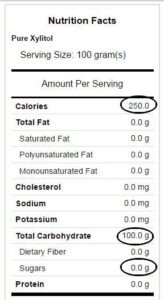Updated: October 04, 2023
Before covering the remaining items listed on the Nutrition Facts label, it is important to clarify a few related items not addressed on the food label. Two frequently used terms are Glycemic Index and Net Carbs. When evaluating food, they are referred to but often not completely understood.
 Glycemic Index
Glycemic Index
The Glycemic Index (GI) is NOT reported on the food label. The Glycemic Index evaluates the rate of rising glucose after eating a particular food. Glycemic index is determined by comparing the rate that blood glucose rises after eating a food to consuming the same amount of glucose. High glycemic foods have relatively rapid absorption of glucose causing a quick spike in “sugar”, triggering a surge in insulin, which then causes glucose (sugar) to fall rapidly. This is important because diets that are rich in high glycemic foods are accompanied by both high and low sugar levels that result in overeating. Medical studies have clearly shown that high glycemic diets are associated with an increased risk of diabetes mellitus and cardiovascular disease. The glycemic index of a food is a relative value.
Glycemic Index (GI) – Table of Some Common Foods1
| High Glycemic Index Foods* | GI > 70 |
|---|---|
| Baked Russet potato | 85 |
| Bagel | 72 |
| Corn Flakes | 84 |
| Rice, instant | 91 |
| Doughnut | 75 |
| Watermelon | 72 |
| Pretzels | 81 |
| Moderate Glycemic Index Foods* | GI 56 – 69 |
|---|---|
| Table sugar (sucrose) | 65 |
| White rice | 56 |
| Brown rice | 55 |
| Cheese pizza | 60 |
| Pineapple | 66 |
| Whole wheat bread | 69 |
| Low Glycemic Index Foods* | GI < 56 |
|---|---|
| Broccoli | <15 |
| Eggplant | <15 |
| Green beans | <15 |
| Orange, raw | 43 |
| Spinach | <15 |
| Apple, raw | 36 |
| Low-fat yogurt, sugar-sweetened | 33 |
*Reference Glucose: GI = 100
As a general rule, processed foods, refined grains, sugary drinks, dried fruits, and refined sugary cereals have a higher Glycemic Index than recommended as part of a healthy diet.
When evaluating the physiologic impact of a specific food serving, we have to take into account the portion size in addition to the glycemic index. This gives us the glycemic load.
 Net Carbs
Net Carbs
What are Net Carbs? Many are familiar with the term but not the significance. Net Carbs identifies the number of carbohydrates that significantly impact our blood sugar after a food is eaten. The Net Carb calculation helps evaluate the ’net effect‘ a food has on blood sugar. Other descriptive terms include ‘impact carbohydrates’ and ‘digestible carbohydrates’. Some experts believe Net Carbs is a reliable way to determine the effect that eating food has on the total amount of sugar absorbed by the body. Net carbs can be calculated by taking the Total Carbohydrate as indicated on the food label, minus Dietary Fiber minus sugar alcohol .2
| Net Carbs = Total Carbohydrates – Dietary Fiber – Sugar Alcohols2 |
|---|
There are two assumptions made when computing Net Carbs using the formula above, fiber is not absorbed and sugar alcohols are not a source of sugar. However, to clarify:
- Fiber is not absorbed: This is NOT entirely accurate. There are two types of fiber, insoluble and soluble. We do NOT derive any calories from insoluble fiber which provides bulk to our stools. It is unclear as to the number of calories and sugar, if any, we derive from soluble fiber.
- Sugar alcohols are not a source of sugar: Sugar alcohols are reduced-calorie sweeteners such as xylitol, sorbitol, and mannitol and are believed to have a reduced but unpredictable effect on blood sugar (per the American Diabetes Association [ADA]). To clarify, their name is a misnomer since sugar alcohols don’t contain any alcohol. Food manufacturers frequently claim that a food is ‘sugar-free’ yet they may be sweetened with sugar alcohols and contribute to the Total Carbohydrates and calories. As an example, note this Nutrition Facts label for xylitol:3

You can see that 100 grams give 250 calories, 100 grams of total carbs, no dietary fiber, no sugar, no protein, and no fat. So where are the calories coming from? Per the ADA, at least some of these calories are from sugar.
The ADA recommends subtracting both half the sugar alcohol and half the total Dietary Fiber from the Total Carbohydrates to estimate the amount of insulin required to control blood sugar after a meal.
So is the ‘Net Carbs’ number really useful?
Consequently, it appears that using the Net Carb formula above underestimates the ‘net effect’ and glycemic load of food.
There are nutritional professionals who believe in the usefulness of Net Carbs determination. Others believe that it is a tool used by the food industry to make their foods appear to deliver fewer carbohydrates and are thus more desirable to consumers. The term Net Carbs is NOT recognized by the FDA. FDA only recognizes and regulates what is reported on the food’s Nutrition Facts label. Again, the concept of Net Carbs is not regulated nor addressed by FDA.
At CardioMender, MD, we use the Net Carb calculation, sometimes without the sugar alcohol component if it is not available, and believe it gives a good general sense of the physiologic impact of food.
Hopefully, this discussion helps clarify the concepts of the Glycemic Index and Net Carbs. You can now use the information found on the Nutrition Facts labels to read between the lines and better understand exactly what you are eating. Use this in conjunction with Part 1: Interpreting Nutritional Labels – Improve Your Understanding, Part 2: How Food Labels Show Minerals and Carbohydrates, and Part 4 coming soon, for better insight into Nutrition Facts food labels and the food you eat.
References:
1. www.prevention.com/food/food-remedies/glycemic-index-and-blood-sugar-levels
2. www.atkins.com/how-it-works/library/articles/what-are-net-carbs
3. www.sparkpeople.com



